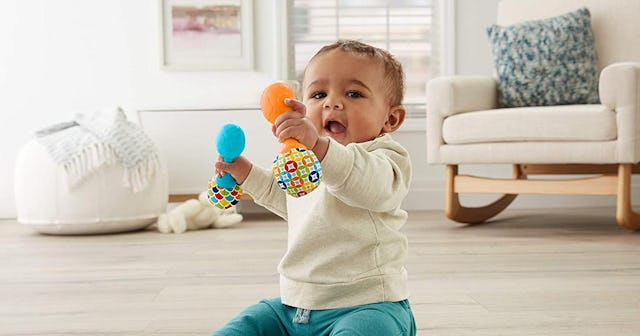Shake It Up: Here Are The Best Rattles For Your Little

Rattle toys might seem old school, but there’s a reason why they’re so tried and true. And yes, toys have come a long way since the days our parents and grandparents were raising babies — toys are now more high-tech, they have more lights, sounds, having scrolling capacities, are Wi-Fi and Bluetooth connected, you name it. But there’s one type of newborn toy that has truly passed the test of time and that’s the rattle toy. It’s barely changed, yet it still wows infants ages 1 week to one year and beyond.
Some of the many benefits of baby rattles are their ability to help build foundational language, motor, and play skills. Jocelyn M. Wood is a speech-language pathologist who specializes in infants and toddlers. The proclaimed baby whisperer and parent coach frequently recommends baby rattles to parents to encourage language development.
“Rattles are a great way to build receptive language (what babies understand) from a very early age, ” says Wood. “Depending on the rattle, it can also be great to build cause and effect in early play, as children shake it and it makes a sound. Brightly colored rattles are wonderful for eye development, and some even make great teethers.”
What is the purpose of a baby rattle?
Rattle toys are relatively simple—they make a sound when your baby shakes or bangs it, and for whatever reason, this sound totally fascinates them. Baby rattles are a great way to improve hand and eye coordination, stimulate their senses, and provide easy and fun entertainment for your little one. There are wooden baby rattle toys, there are plastic baby rattle toys and there are even some more fancy rattle toys, and all of them do two key things that make babies go crazy with joy: shake and make a rattling sound.
At what age do babies like rattles?
Babies love toys that make noise! As soon as 10 weeks, babies can enjoy the sounds of a rattle. Whether it’s dangling on their play gym or you’re waving it around for them, they’ll be fascinated and entertained. Around 6 months old, babies begin developing motor skills and are able to grab and shake the rattles themselves.
“Early on (0-3 months) babies start to distinguish between different pitches and tones, so rattles are a great way to provide these contrasts. A bit later, at 3-6 months, babies learn to localize to sound by turning their head towards what they are hearing,” Wood adds. “Caregivers can use them as early as 1 week old, when it feels like their baby can’t really play, to watch the baby’s startle reflex engage when hearing a loud sound.”
Of course, there is no shortage of baby rattle toys on the market—and you can buy them from just about any baby store—but there are some that are a clear cut above the rest and turn out to be true new-parent lifesavers. Here are the best baby rattle toys on the market to keep your baby calm, cool, and collected.
Best Baby Rattle Toys
Wooden Rattles
Baby Wrist Rattles
SHOP THE STORY
This article was originally published on